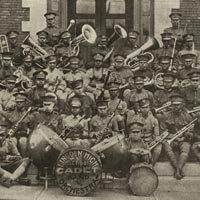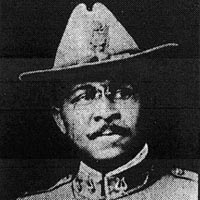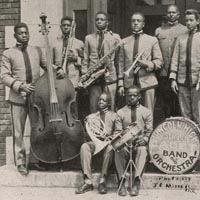Major N. Clark Smith
![]() Major N. Clark Smith, "America's Greatest Colored Bandmaster," exerted considerable influence on the development of Kansas City jazz, drilling his students on the basics of music theory and performance. Many first generation Kansas City jazz musicians studied with Smith, including
Major N. Clark Smith, "America's Greatest Colored Bandmaster," exerted considerable influence on the development of Kansas City jazz, drilling his students on the basics of music theory and performance. Many first generation Kansas City jazz musicians studied with Smith, including ![]() Walter Page, Julia Lee, Harlan Leonard,
Walter Page, Julia Lee, Harlan Leonard, ![]() Leroy Maxey, Lamar Wright, Jasper Allen, and DePriest Wheeler. Harlan Leonard remembered Smith as "the music program at Lincoln" High School. He had "a vivid and commanding personality. He was short, chubby, gruff, military in bearing, wore glasses, and was never seen without his full uniform and decorations. His language was rather rough and occasionally shocking to the few young ladies who were taking music classes, though never offensive. Major Smith simply ran a tight ship ... He drilled the Lincoln marching bands until they were the best in the area, some said the best of their kind in the Middle West." A strict disciplinarian, Smith often reprimanded his students with the business end of his ruler. Saxophonist Williams Saunders regretted the day he forgot the elements of music when called upon in class. Smith commanded him to come to the front of the room and put his head on a desk. Striking Saunders on the head with a ruler, Smith reminded him that "music is melody, BOOM!; harmony, BOOM! and rhythm, BOOM!" Smith further instructed Saunders to "go home and tell your mammy I hit you." It was a lesson Saunders never forgot. Decades later, he simply stated, "I know what music is."
Leroy Maxey, Lamar Wright, Jasper Allen, and DePriest Wheeler. Harlan Leonard remembered Smith as "the music program at Lincoln" High School. He had "a vivid and commanding personality. He was short, chubby, gruff, military in bearing, wore glasses, and was never seen without his full uniform and decorations. His language was rather rough and occasionally shocking to the few young ladies who were taking music classes, though never offensive. Major Smith simply ran a tight ship ... He drilled the Lincoln marching bands until they were the best in the area, some said the best of their kind in the Middle West." A strict disciplinarian, Smith often reprimanded his students with the business end of his ruler. Saxophonist Williams Saunders regretted the day he forgot the elements of music when called upon in class. Smith commanded him to come to the front of the room and put his head on a desk. Striking Saunders on the head with a ruler, Smith reminded him that "music is melody, BOOM!; harmony, BOOM! and rhythm, BOOM!" Smith further instructed Saunders to "go home and tell your mammy I hit you." It was a lesson Saunders never forgot. Decades later, he simply stated, "I know what music is."
Smith arrived at Lincoln High School well-equipped to take charge of the music and military programs. Born on July 31, 1877, at Fort Leavenworth, Kansas, Nathaniel Clark Smith attended the Army Service School where he studied with German bandmaster, Professor H. E. Gungle. After graduation, Smith briefly worked for the ![]() publishing house of Carl Hoffman in Kansas City, Missouri. In 1891 he began his military career as a trumpeter at Fort Sill, Oklahoma. Two years later he married and moved to Wichita, Kansas, where he organized youth and YMCA bands. While in Chicago leading a band at the 1893 World's Fair, Smith joined the Lyon and Healy music company as an agent, organizing bands and choruses. Smith served as band master for the Eighth Illinois Infantry for four years, touring Cuba during the Spanish-American war.
publishing house of Carl Hoffman in Kansas City, Missouri. In 1891 he began his military career as a trumpeter at Fort Sill, Oklahoma. Two years later he married and moved to Wichita, Kansas, where he organized youth and YMCA bands. While in Chicago leading a band at the 1893 World's Fair, Smith joined the Lyon and Healy music company as an agent, organizing bands and choruses. Smith served as band master for the Eighth Illinois Infantry for four years, touring Cuba during the Spanish-American war.
Returning to Kansas City in 1898, Smith organized a youth band. Vaudevillians Billy McClain and Ernest Hogan promoted an eighteen-month tour of Europe and Australia for Smith and the band. The group, which included a band, orchestra and glee club, performed at the 1900 Paris Exposition. Furthering his education, Smith attended the Chicago Musical College, graduating in 1905. He also attended the University of Kansas at Lawrence and the Horner Institute of Fine Arts in Kansas City, Missouri. In 1907, Smith received a commission as bandmaster at the Tuskegee Institute in Alabama, awarded by a board member, Theodore Roosevelt. Booker T. Washington enthusiastically received Smith, who in turn composed "The Tuskegee March" in honor of Washington. Advancing the music program, Smith organized touring bands that traveled across the nation by Pullman cars. On July 3, 1913, the Tuskegee Band, led by Smith, ![]() performed at Convention Hall in Kansas City for the national convention of the Elks. That fall, at the request of his benefactor Theodore Roosevelt, Captain Smith joined the military department at Western Baptist University in Kansas City, Kansas, a historic institution built on the site in Quindaro where abolitionist John Brown ferried slaves to freedom.
performed at Convention Hall in Kansas City for the national convention of the Elks. That fall, at the request of his benefactor Theodore Roosevelt, Captain Smith joined the military department at Western Baptist University in Kansas City, Kansas, a historic institution built on the site in Quindaro where abolitionist John Brown ferried slaves to freedom.
Smith quickly established military discipline and training to the choir and bands at Western University. In January 1915, Smith became commandant of Western's Military department. He presented ![]() concerts in the community, combining the choruses of Western and Allen Chapel. That summer he led the band at the newly-opened Lincoln Electric Park, a local amusement park, and organized a
concerts in the community, combining the choruses of Western and Allen Chapel. That summer he led the band at the newly-opened Lincoln Electric Park, a local amusement park, and organized a ![]() 260-member band and chorus. In the summer of 1916, Smith directed the
260-member band and chorus. In the summer of 1916, Smith directed the ![]() Coleridge-Taylor Music Settlement School and in the fall, he joined the faculty of Lincoln High School, a move facilitated by Western University's chronic financial problems. Lincoln needed a band master as well as military instructor and Smith fit the bill for both positions.
Coleridge-Taylor Music Settlement School and in the fall, he joined the faculty of Lincoln High School, a move facilitated by Western University's chronic financial problems. Lincoln needed a band master as well as military instructor and Smith fit the bill for both positions.
Arriving at Lincoln on September 5, 1916, Smith quickly took charge of both programs, organizing drills three days a week and music instruction the other two. At the start of the school year, only five band members could play instruments, but by the end of the year the band included 30 playing members. Smith organized a 30-member girls glee club, a 24-member boys glee club and a 15-piece orchestra. The glee clubs performed popular standards and spirituals, including Smith's arrangement of "Steal Away to Jesus." The orchestra played light classical selections including Cavalleria Rusticana and Traumerei.
While jazz was not part of the Lincoln curriculum, Smith did not discourage his students from playing it. A description of the activities of the music program in the 1919 Lincoln yearbook, the Lincolnian, includes an addendum praising Walter Page's jazz orchestra: "lastly, I must not forget Page's jazz orchestra that furnishes music during the lunch period. It is some orchestra. I say it is!" In 1922, Smith publically embraced jazz by making "a plea for the catchy type of music made famous by Lieutenant Europe in France, and commonly called jazz" at a memorial service for James Reese Europe held in Chicago.
Smith moved to Chicago in 1922, organizing Pullman Porter singing groups and teaching at Wendell Phillips High School, where his students included Lionel Hampton. Moving to St. Louis in 1931, Smith joined the faculty at Sumner High School. In 1930, Smith won the Wannamaker Prize for his composition, ![]() Negro Folk Suite, performed three years later by the St. Louis Symphony. The CBS network broadcast Smith's St. Louis Blues radio program, originating from KMOX, for three years. In June 1935, Smith returned to Kansas City to concentrate on publishing his music. After walking from his home to the Musicians Protective Union Local 627 at 1823 Highland, Smith suffered a fatal stroke and died on October 8, 1935.
Negro Folk Suite, performed three years later by the St. Louis Symphony. The CBS network broadcast Smith's St. Louis Blues radio program, originating from KMOX, for three years. In June 1935, Smith returned to Kansas City to concentrate on publishing his music. After walking from his home to the Musicians Protective Union Local 627 at 1823 Highland, Smith suffered a fatal stroke and died on October 8, 1935.




